Closed Loop AIO Liquid Coolers: 14-way Mega Roundup Review
by E. Fylladitakis on February 12, 2014 7:00 AM ESTTesting Results, Low Fan Speed (7V)
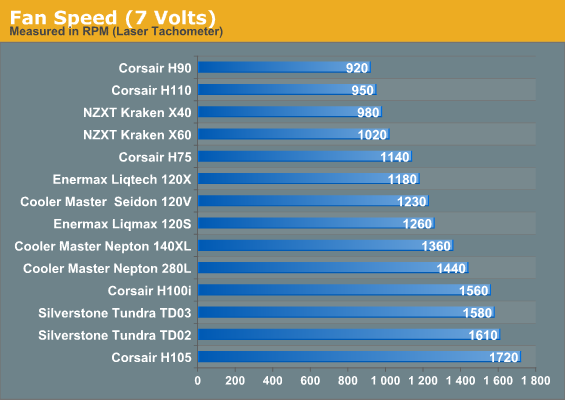
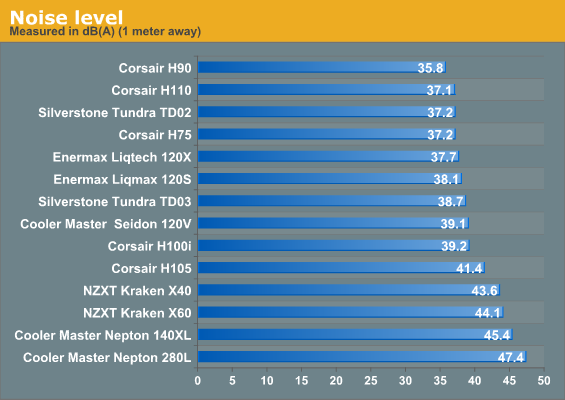
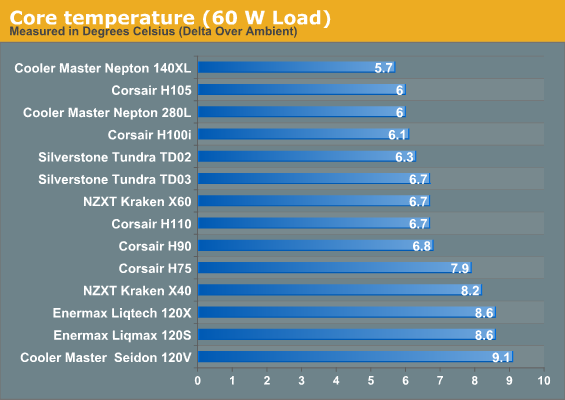

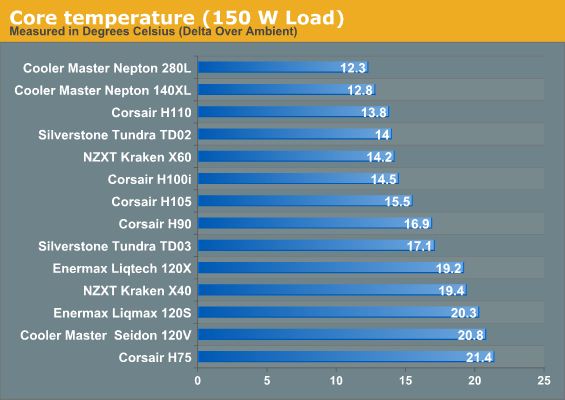
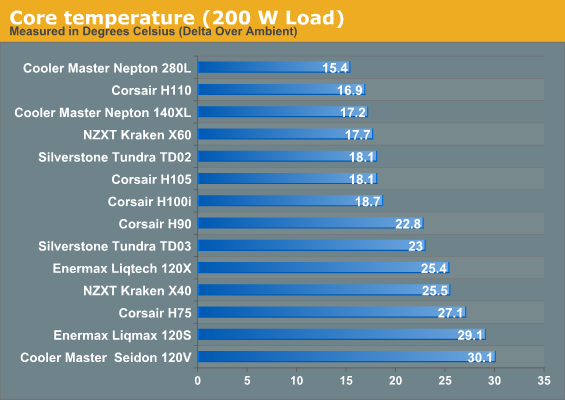
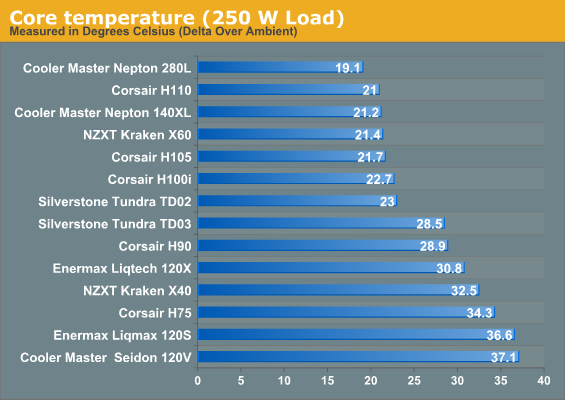
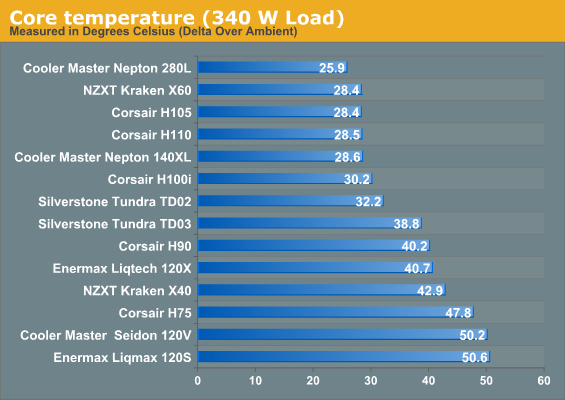
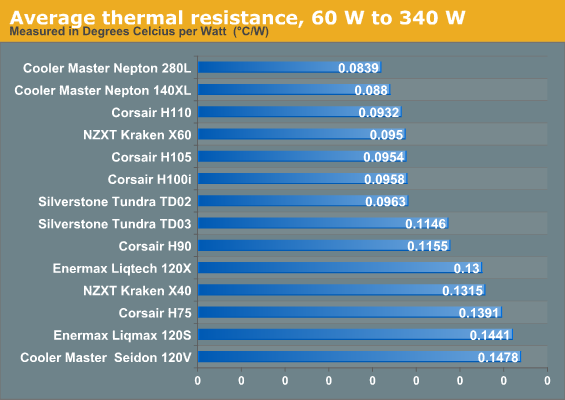
After dropping the voltage of the fans down to 7V, the characteristic performance of several AIO coolers changes quite a bit. As expected, the performance gap between most single and dual fan radiator models widens, as the larger surface maintains a greater heat dissipation rate as the flow rate decreases. The charts are once again led by Cooler Master's Nepton coolers, although that hardly qualifies as "low noise testing" as both coolers still generate high noise levels and are most definitely unsuitable for a low noise environment.
Corsair's H110 displays tremendous thermal performance under very heavy load, in conjunction with very low noise levels. NZXT's Kraken X60 delivers about the same thermal performance, which was to be expected as it virtually is the same design, yet the noise levels are significantly higher; apparently, Corsair chose their fans a bit more wisely (or they just got lucky). Silverstone's Tundra TD02 also fares considerably better this time, rivaling the high load thermal performance of all other 240mm coolers at considerably lower noise levels. Under low thermal loads, the Tundra TD02 manages to outperform most of the dual 120mm and 140mm coolers. Apparently, the large and thick radiator of the TD02 allows it to maintain high performance figures even when the airflow is reduced.
Those who are interested only in noiseless operation and are looking at AIO coolers as a high-performance, low noise alternative to CPU coolers should be careful with their selections. It is not always possible to reduce the speed of the stock fans or replace them in order to reduce the noise generated by the kit. For example, the fan of the Cooler Master Seidon 120V is virtually noiseless when its voltage is dropped down to 7V; the pump however is not, making a clearly audible, high pitch noise. This is also true for the Enermax Liqmax 120S, as the pump of this kit makes a whining noise as well, although the noise of its pump is significantly lower. On the other hand, the Corsair H90 is not the best performing or, due to its size, the most convenient kit of the roundup, yet it is entirely silent when its fan's voltage is reduced down to 7 Volts.










139 Comments
View All Comments
Dustin Sklavos - Wednesday, February 12, 2014 - link
Good lord.If I'd known my successor would produce results this thorough I'd've stepped aside a long time ago.
Really well done piece of work.
E.Fyll - Wednesday, February 12, 2014 - link
Thank you for the praise Dustin, yet I still stand unworthy of it. :)Dustin Sklavos - Wednesday, February 12, 2014 - link
I'm enjoying your work tremendously. Now that I'm at Corsair I'm glad we have someone we can send case/cooling/PSU hardware to that meets and beats the AnandTech standard.creed3020 - Wednesday, February 12, 2014 - link
Yeah Dustin....I have seriously enjoyed your labors here at AT and do miss them. Your successor has changed the paradigm so much that it's hard to compare, but it's a awesome reboot to this area of reviews here at AT.I, however, have to agree with many other commenters that a secondary dataset produced with the same 120mm/140mm fans does have it's merit as it will provide an objective evaluation of the radiator and pumps. This is one area where I am really curious to see quality differences in the products. I am fully aware that each OEM is very careful in their selection of a fan which matches their product. This is not done by lottery, that much is clear to me. The OEM behind the Silverstone/Enermax product intrigues me, as I am a fan of Silverstone products and use their cases exclusively for all of my desktops, gaming PCs, and HTPCs. The Tundra's seems like they are ripe for a revision!
BigLeagueJammer - Wednesday, February 12, 2014 - link
Under Noise Level Reference Values, your first one of <35dB(A) being "Virtually inaudible" doesn't match up with most sources I've seen. Most rate that as "very quiet" and say the limit of human hearing as 10 db(A). If other sources say things like a ticking watch is around 20 db(A) which in a quiet room is easy to hear, then 35 seems too high for your qualification of "virtually inaudible".E.Fyll - Wednesday, February 12, 2014 - link
True, I am afraid that the lot of "copy/paste-ing" online has produced a lot of bad information going around. Some are works of fiction, some are misinterpretations of confused people, some...I don't even want to know.So, copying my answer from above:
"Sub-35 dB(A) levels are generally impossible to notice by a human ear. Sub-30 dB(A) levels are next to impossible to record with anything less than science lab-grade equipment. There is no handheld or desktop dB(A) meter that can perform such readings. If you have seen reviews stating sub-30 dB(A) levels, make sure to check their methodology (given that there is any). Either the meter cannot read lower than 30 dB(A) (and/or will display a bogus reading, as most cheap Chinese meters do) and the review is a fictional text or their methodology is based on dB readings, not dB(A) readings, which is useless to a consumer."
I think it will suffice for me to say that you cannot possibly hear what an instrument designed for this specific purpose cannot even record. In theory, the human hearing threshold is 1 dB(A); in practice however, that is true only for specific frequencies. The background noise of a typical room is almost always above 32-33dB(A).
Jon-R - Wednesday, February 12, 2014 - link
What is your opinion on the tests done over at SilentPCReview? They test using lab-grade equipment. A rundown can be found here: http://www.silentpcreview.com/article875-page2.htm...They use reference fans which measure around 13dBA at their slowest fan speeds, and they don't think highly of AIO water-cooling at all, as none of the tested ones have come close to the best air-coolers when it comes to quiet cooling.
E.Fyll - Wednesday, February 12, 2014 - link
From what I can see, they are using a highly sensitive microphone and a computer's sound card to record the results, connected through an amplifier. Although the equipment is very good, this is not "lab grade equipment" but just a customized setup. A very good setup nonetheless, including an anechoic chamber. They have a microphone with a self-noise of 8 dB, which measures 11 dB(A) inside the aforementioned anechoic chamber.It will suffice to say that their results are just in no way comparable to mine. Actually, as noise level measurements are environment-specific, you should only compare the results of a same setup, never in-between different setups. Unless they are all science labs with multiple ISO certifications, of course. Given that my room floor noise level is over 30 dB(A) and they are using a sub-12 dB(A) anechoic chamber, I believe that I do not have to stress how different the results out of these two setups are.
As far as equipment goes, for example, this is a cheap lab grade sound analyzer and still costs 5 times more than the whole setup that you showed me, microphones and secondary equipment aside:
http://www.nti-audio.com/en/products/flexus-fx100....
Jon-R - Wednesday, February 12, 2014 - link
But you're not saying that their measurements are inaccurate, only that they've got a significantly lower noise-floor than what you're using? So it boils down to the difference between what is considered silent? Because 30dBA is louder than their reference fan it its loudest setting, and far beyond what they consider acceptable. Just as a reference, they measured 43 dBA for the Silverstonde TD03 at 12v, and 30 dBA at 7v.E.Fyll - Wednesday, February 12, 2014 - link
"Inaccurate" is a harsh word when it comes to sound pressure level measurements. Although I would not hesitate to use this word for most other types of tests, there are far too many variables at stake here. I believe that their setup may be better than mine. I am just using a good handheld sound level meter, with the product positioned in the middle of a standard room.I would simply stick with "different".
Sound levels are additive. If you have a noise source of 20 dB(A) and added another source of 20 dB(A), the room noise would not be 20 dB(A) but 23 dB(A). A third source would make it 24.8 dB(A) and so on. So, a fan that would measure 18 dB(A) inside an 12 dB(A) anechoic chamber, will still add to the 30.4 dB(A) floor noise of my room. The difference is the magnitude, as the scale is logarithmic. As you said, the TD03 added about 18 dB(A) and 30 dB(A) to their setup, when it adds 8.3 dB(A) and 17.7 dB(A) to mine, because of the higher background noise. These differences are in no way comparable to each other; that is only possible when the scale is linear. The further you move up the decibel scale, the largest the increase of SPL becomes per single decibel.